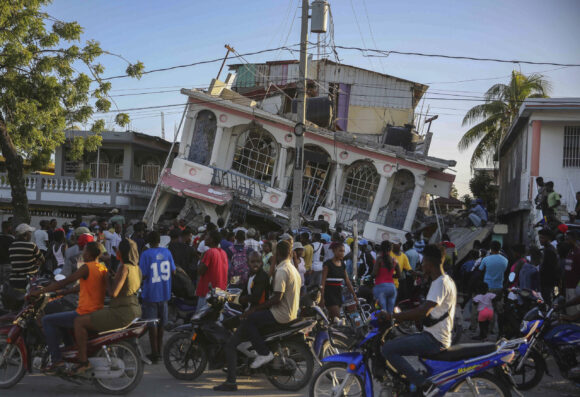CCRIF SPC, the Cayman Islands-based parametric catastrophe facility, will pay approximately US$40 million to the government of Haiti, following the devastating magnitude 7.2 earthquake, which struck the Caribbean island on Aug. 14, significantly affecting the city of Les Cayes.
This payout represents the full coverage limit under the country’s parametric insurance policy for earthquakes for the 2021/22 policy year. As CCRIF’s insurance policies are parametric, payouts are made within 14 days of an event.
To begin to support the people of Haiti as quickly as possible, CCRIF will provide a first tranche of US$15 million to the government within one week of the event and the remaining amount of approximately US$25 million within the 14-day window, to allow for the independent verification of the model results.
CCRIF will continue to provide earthquake coverage to Haiti for the remainder of the policy year, which ends on May 31, 2022, under a special feature of the earthquake policy known as the Reinstatement of Sum Insured Cover (RSIC). The RSIC, introduced by CCRIF in 2017, provides access to coverage after the maximum coverage limit of a country’s earthquake or tropical cyclone coverage limit has been reached.
This current payout to Haiti will represent CCRIF’s largest single payout to date. Since the facility’s inception in 2007, it has made 53 payouts totaling US$242.4 million to 16 of its 23 members. Of these, Haiti has received five payouts totaling US$78.3 million (32% of total payouts).
“The payout from CCRIF to the Republic of Haiti following the earthquake on Aug. 14, 2021, will help finance rapid and tangible government activities geared towards supporting the poor and vulnerable affected by the earthquake in the Grand Sud region,” commented Haiti’s Minister of the Economy and Finance Michel Patrick Boisvert.
“Given the proliferation and recurrence of natural disasters, access to parametric insurance policies offered by CCRIF and other risk financing mechanisms makes it possible to better manage the impact of these disasters on public finances and strengthen financial resilience in the medium term. For a country like Haiti, which is exposed to multiple natural disaster risks, it is imperative for us to adopt preventive measures to reduce vulnerability to shocks, while improving disaster preparedness and response,” he added.
The Aug. 14 earthquake was centered near Petit Troup de Nippes, approximately 78 miles to the west of the capital city Port-au-Prince and released approximately twice as much energy as the 7.0 earthquake that affected the country in 2010. Both quakes occurred on the same fault line but the 2010 earthquake occurred nearer to the capital – about 15 miles west of Port-au-Prince. After the 2010 earthquake, the government of Haiti received a payout of US$7.8 million from CCRIF.
Since 2010 the government of Haiti has continued to increase its parametric insurance coverage for earthquakes, with the cumulative increase being about 400%. This increased coverage has been made possible through premium support initially provided by the Canadian government and subsequently by the Caribbean Development Bank, which has paid Haiti’s insurance premiums for earthquakes, tropical cyclones and excess rainfall either fully or in part.
Since the start of the 2021 Atlantic Hurricane Season, Haiti has been affected by tropical cyclones Elsa and Fred. Haiti received a payment of approximately US$343,000 under the aggregated deductible cover (ADC) of its tropical cyclone policy following cyclone Elsa. The ADC provides a minimum payment for events that are not sufficient to trigger a country’s tropical cyclone policy but for which losses on the ground are registered by a member government.
About CCRIF SPC
CCRIF SPC is a segregated portfolio company that limits the financial impact of catastrophic hurricanes, earthquakes and excess rainfall events to Caribbean and Central American governments by quickly providing short-term liquidity when a parametric insurance policy is triggered. It is the world’s first regional fund utilizing parametric insurance, giving member governments the opportunity to purchase earthquake, hurricane and excess rainfall catastrophe coverage for the lowest-possible prices.
CCRIF was developed under the technical leadership of the World Bank and with a grant from Japan. It was capitalized through contributions to a Multi-Donor Trust Fund (MDTF) by the government of Canada, the European Union, the World Bank, the governments of the UK and France, the Caribbean Development Bank and the governments of Ireland and Bermuda, as well as through membership fees paid by participating governments.
Photograph: People gather outside the Petit Pas Hotel, destroyed by the earthquake in Les Cayes, Haiti, on Saturday, Aug. 14, 2021. A 7.2 magnitude earthquake struck Haiti on Saturday, with the epicenter about 125 kilometers (78 miles) west of the capital of Port-au-Prince, the US Geological Survey said. Photo credit: AP Photo/Joseph Odelyn.
Was this article valuable?
Here are more articles you may enjoy.


 NYT Asks Judge to Dismiss Trump’s ‘Implausible’ Defamation Suit
NYT Asks Judge to Dismiss Trump’s ‘Implausible’ Defamation Suit  Twice Injured Firefighter Loses Second Workers’ Compensation Claim
Twice Injured Firefighter Loses Second Workers’ Compensation Claim  LA Fires Push Insurers’ 2025 Disaster Losses to $107 Billion
LA Fires Push Insurers’ 2025 Disaster Losses to $107 Billion  Flooding in California Leads to Soaked Roads, Water Rescues and 1 Death
Flooding in California Leads to Soaked Roads, Water Rescues and 1 Death 